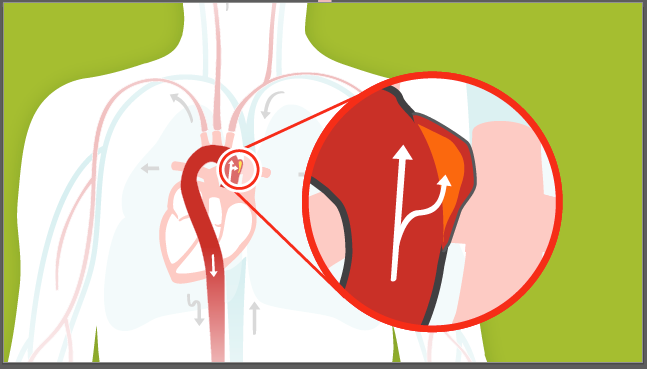动脉瘤的类型
Abdominal aortic aneurysm

An abdominal aortic aneurysm (AAA) occurs when the large blood vessel (the aorta) that supplies blood to the abdomen, pelvis and legs becomes weakened, enlarged or balloons outward. This type of aneurysm occurs most often in older men who have at least one or more risk factor, 包括肺气肿, 家族病史, 高血压, 高胆固醇, 吸烟,可能的话, 肥胖. Women with an AAA generally suffer ruptures more often and with smaller sizes of aneurysms.
The rupture of an abdominal aortic aneurysm is a medical emergency. Call 911 and seek medical attention right away if you or someone you know has extreme pain in the belly or back that doesn't go away. Learn more about this type of aneurysm.
脑动脉瘤

脑动脉瘤s, which affect about 3% to 5% of the U.S. 人口, occur when the wall of a blood vessel in the brain becomes weakened and bulges or balloons out. The three types of 脑动脉瘤s are: berry (saccular), fusiform and mycotic.
The berry aneurysm is the most common and occurs more often in adults. It can range in size from a few millimeters to more than two centimeters. A 家族病史 of aneurysms may increase your risk.
Conditions that injure or weaken the walls of the blood vessel, including 动脉粥样硬化, 创伤或感染, may also cause 脑动脉瘤s. Other risk factors include polycystic kidney disease, narrowing of the aorta and 心内膜炎.
Like other types of aneurysms, 脑动脉瘤s may not have any symptoms. But symptoms may include:
- 严重的头痛
- Pain above and behind the eye
- 麻木
- 弱点
- Paralysis on one side of the face
- A dilated pupil in the eye
- Vision changes or double vision
- 恶心或呕吐
- 脖子僵硬
- 对光的敏感度
- 癫痫发作
- Loss of consciousness (brief or prolonged)
- 心脏骤停
A ruptured 脑动脉瘤 is a medical emergency. Call 911 and seek medical attention right away if you or someone you know has symptoms. Learn more about 脑动脉瘤s.
Thoracic aortic aneurysm
A thoracic aortic aneurysm is an abnormal bulging or ballooning of the part of the aorta that passes through the chest down to the diaphragm. 一个常见的原因是 动脉粥样硬化, or hardening of the arteries.
Other risk factors include:
- 男性的性别
- 老化
- 高血压
- Chronic obstructive pulmonary disease
- 吸烟
- Previous aortic dissection
- Genetic conditions, such as Marfan syndrome
- Inflammation of the aorta
- Injury from chest wall trauma
- Infections, such as syphilis and tuberculosis
A person with an aneurysm may not experience any symptoms until the aneurysm begins to expand or “leak” blood into nearby tissue.
Symptoms of a thoracic aortic aneurysm may include:
- 声音沙哑
- 吞咽问题
- High-pitched breathing
- 颈部肿胀
- Chest or upper back pain
- 皮肤湿冷
- 恶心和呕吐
- 心率加快
- Sense of impending doom
A ruptured thoracic aortic aneurysm is a medical emergency. Call 911 and seek medical attention right away if you or someone you know has symptoms. Learn more about this type of aneurysm.




